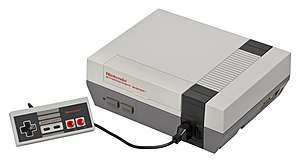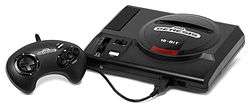1980s in video games
The 1980s was the second decade in the industry's history. It was a decade of highs and lows for video games. The decade began amidst a boom in the arcade business with giants like Atari still dominating the market since the late-1970s. Another, the rising influence of the home computer, and a lack of quality in the games themselves lead to an implosion of the North American video game market that nearly destroyed the industry.[1] It took home consoles years to recover from the crash, but Nintendo filled in the void with its Nintendo Entertainment System (NES), reviving interest in consoles.[2] Up until this point, most investors believed video games to be a fad that has since passed.[3] In the remaining years of the decade, Sega ignites a console war with Nintendo, developers that had been affected by the crash experimented with the more advanced graphics of the PC,[4] and Nintendo released the Game Boy, which would become the best-selling handheld gaming device for the next two-decades.[5]
| 1970s . 1980s in video games . 1990s |
| Other events: 1980s . Games timeline |

Consoles of the 1980s
Third generation consoles 1983–1995

Starting in 1983 the third generation began with the Japanese release of the Family Computer (or "Famicom"; later known as the Nintendo Entertainment System in the rest of the world) by Nintendo. Although the previous generation of consoles had also used 8-bit processors, it was at the end of this generation that home consoles were first labeled by their "bits". This also came into fashion as 16-bit systems like Sega's Genesis were marketed to differentiate between the generations of consoles. In the United States, this generation in gaming was primarily dominated by the NES/Famicom. Other notable consoles included Sega's Mark III, also known as the Master System.
Fourth generation consoles 1987–1996

Starting in 1987 with the PC Engine in Japan and ending in 1996, with the last console being the Neo-Geo in 1991, the fourth generation of video game consoles consisted primarily of games and systems programmed for the 16-bit era. During this generation, 2D graphics had improved over the previous generation and experimentation began to occur with 3D graphics, although 3D games were more prevalent on the PC at the time. The fourth generation also was the first time compact discs were considered a viable port for video game retail sales with the CD-i. Some of the most notable systems released during this generation were the Super Famicom/Super Nintendo Entertainment System (1990), the Sega Mega Drive/Genesis (1988), and the Neo Geo (1991).[6] Nintendo's Game Boy was also released during the fourth generation, which would later become the most popular series of handheld gaming systems during the 1990s.[7] A rivalry between Sega and Nintendo occurred during this generation, starting the first ever console war.
History
Golden age of arcade games
In the early-1980s, arcade games were a vibrant industry. The arcade video game industry in the US alone was generating $5 billion of revenue annually in 1981[8] and the number of arcades doubled between 1980 and 1982.[9] The effect video games had on society expanded to other mediums as well such as major films and music. In 1982, "Pac-Man Fever" charted on the Billboard Hot 100 charts[10] and Tron became a cult classic.[11]
Third-party development and an oversaturated market
Following a dispute over recognition and royalties, several of Atari's key programmers split and founded their own company Activision in late 1979.[12] Activision was the first third-party developer for the Atari 2600.[13] Atari sued Activision for copyright infringement and theft of trade secrets in 1980,[14] but the two parties settled on fixed royalty rates and a legitimizing process for third parties to develop games on hardware.[15]
In the aftermath of the lawsuit, an oversaturated market resulted in companies that had never had an interest in video games before beginning to work on their own promotional games; brands like Purina Dog Food.[16] The market was also flooded with too many consoles and too many poor quality games,[17] elements that would contribute to the collapse of the entire video game industry in 1983.
Video game crash of 1983
By 1983, the video game bubble created during the golden age had burst and several major companies that produced computers and consoles had gone into bankruptcy.[18] Atari reported a $536 million loss in 1983.[19] Some entertainment experts and investors lost confidence in the medium and believed it was a passing fad.[20] A game often given poster child status to this era, E.T. the Extra-Terrestrial had such bad sale figures that the remaining unsold cartridges were buried in the deserts of New Mexico.[21][22]
Rise of home computing and PC gaming
The brunt of the crash was felt mainly across the home console market. Home computer gaming continued to thrive in this time period, especially with lower-cost machines such as the Commodore 64 and ZX Spectrum. Some computer companies adopted aggressive advertising strategies to compete with gaming consoles and to promote their educational appeal to parents as well.[23][24] Home computers also allowed motivated users to develop their own games, and many notable titles were created this way, such as Jordan Mechner's Karateka, which he wrote on an Apple II while in college.[25]
In the late 1980s, IBM PC compatibles became popular as gaming devices, with more memory and higher resolutions than consoles, but lacking in the custom hardware that allowed the slower console systems to create smooth visuals.[26]
Rejuvenation
By 1985, the home market console in North America had been dormant for nearly two years. Elsewhere, video games continued to be a staple of innovation and development. After seeing impressive numbers from its Famicom system in Japan, Nintendo decided to jump into the North American market by releasing the Nintendo Entertainment System, or NES for short. After release it took several years to build up momentum, but despite the pessimism of critics it became a success. Nintendo is credited with reviving the home console market.[2]
One innovation that led to Nintendo's success was its ability to tell stories on an inexpensive home console; something that was more common for home computer games, but had only been seen on consoles in a limited fashion. Nintendo also took measures to prevent another crash by requiring third-party developers to adhere to regulations and standards, something that has existed on major consoles since then. One requirement was a "lock and key" system to prevent reverse engineering. It also forced third parties to pay in full for their cartridges before release, so that in case of a flop, the liability will be on the developer and not the provider.[27]
Post-Revival
Notable video-game franchises established in the 1980s
Arcade
- 1942 (1984)
- Arkanoid (1986)
- Balloon Fight (1984)
- Baraduke (1985)
- Bomb Jack (1984)
- Bubble Bobble (1986)
- BurgerTime (1982)
- Contra (1987)
- Centipede (1981)
- Defender (1981)
- Dig Dug (1982)
- Donkey Kong (1981)
- Double Dragon (1987)
- Dragon's Lair (1983)
- Frogger (1981)
- Gauntlet (1985)
- Ghouls 'n Ghosts (1988)
- Golden Tee Golf (1989)
- Gradius (1985)
- Joust (1982)
- Ikari Warriors (1986)
- Missile Command (1980)
- Mr. Do! (1982)
- Mappy (1983)
- OutRun (1986)
- Pac-Man (1980)
- Pole Position (1982)
- Q*bert (1982)
- Qix (1981)
- Rally-X (1980)
- Robotron: 2084 (1982)
- R-Type (1987)
- Spy Hunter (1983)
- Street Fighter (1987)
- Tempest (1981)
- Track & Field (1983)
- TRON1 (1982)
- World Stadium (1988)
- Xevious (1982)
- Zaxxon (1982)
Home computers and console
- Alternate Reality (1985)
- Alex Kidd in Miracle World (1986)
- The Bard's Tale (1985)
- Bomberman (1983)
- Bonk's Adventure (1989)
- Boulder Dash (1984)
- Wolfenstein (1981)
- Castlevania (1987)
- Circus Charlie (1984)
- Choplifter (1982)
- Dragonslayer (1984)
- Dragon Quest (1986)
- Duck Hunt (1984)
- Dungeon Master (1987)
- Elite (1984)
- Excitebike (1984)
- Final Fantasy (1987)
- Fishing Derby (1980)
- Jetpac (1983)
- James Bond (1983)
- Karateka (1984)
- King's Quest (1983)
- Kid Icarus (1986)
- The Legend of Heroes (1989)
- Leisure Suit Larry (1987)
- Ice Climber (1984)
- The Legend of Zelda (1986)
- Lode Runner (1983)
- Madden NFL (1988)
- Manic Miner (1983)
- Maniac Mansion (1987)
- Mega Man (1987)
- Metal Gear (1987)
- Metroid (1986)
- Microsoft Flight Simulator2 (1982)
- Might and Magic (1986)
- Ninja Gaiden (1988)
- Phantasy Star (1987)
- Pitfall! (1982)
- Populous (1989)
- Prince of Persia (1989)
- Romance of the Three Kingdoms (1985)
- Rocky's Boots (1982)
- The Prisoner1 (1980)
- Shadow of the Beast (1989)
- Sid Meier's Pirates! (1987)
- SimCity (1989)
- Space Quest (1986)
- Starflight (1986)
- Super Mario (1985)
- Test Drive (1987)
- Tetris (1984)
- Thexder (1985)
- Ultima (1981)
- Urban Champion (1984)
- Warlords (1989)
- Where in the World is Carmen Sandiego? (1985)
- Wasteland (1988)
- Wonder Boy (1986)
- Wizardry (1981)
- Ys (1987)
Notes:
- 1Game franchises that also accompany major film or television franchises.
- 2Game franchises that are considered spin-offs of previously established franchises.
Best-selling video games of the decade
The following table lists the best-selling video games of the 1980s. Note that video game sales numbers were not as widely reported during the 1980s, with the exception of NES titles.
| No. | Title | Units sold | Initial release date | Platform(s) | Genre(s) | Developer(s) | Publisher(s) | Ref |
|---|---|---|---|---|---|---|---|---|
| 1 | Super Mario Bros. | 40.24 million | September 13, 1985 | NES | Platformer | Nintendo Creative Department | Nintendo | [28] |
| 2 | Tetris | 30.26 million | c. 1984–1989[lower-alpha 1] | Multi-platform | Puzzle | Various | Various | |
| 3 | Duck Hunt | 28.31 million | April 29, 1984 | NES | Light gun shooter, sports | Nintendo R&D1 | Nintendo | [30] |
| 4 | Super Mario Land | 18.37 million | April 21, 1989 | Game Boy | Platformer | Nintendo R&D1 | Nintendo | [lower-alpha 2] |
| 5 | Super Mario Bros. 3 | 17.28 million | October 23, 1988 | NES | Platformer | Nintendo EAD | Nintendo | [33] |
| 6 | Super Mario Bros. 2 | 7.46 million | October 9, 1988 | NES | Platformer | Nintendo EAD | Nintendo | [31] |
| 7 | Pac-Man | 7.00 million | March 16, 1982 | Atari 2600 | Maze | Atari | Atari | [34] |
| 8 | The Legend of Zelda | 6.51 million | February 21, 1986 | NES | Action-adventure | Nintendo EAD | Nintendo | [35] |
| 9 | Zelda II: The Adventure of Link | 4.38 million | January 14, 1987 | NES | Action role-playing, platformer | Nintendo EAD | Nintendo | [36] |
| 10 | Excitebike | 4.16 million | November 30, 1984 | NES | Racing | Nintendo R&D1 | Nintendo | |
| 11 | Pitfall! | >4.00 million[lower-alpha 3] | April 20, 1982 | Atari 2600 | Platformer | Activision | Activision | [37][38] |
References
- "The Video Game Crash of 1983".
- "A 20-Year Old Legend".
- "Top 10 Embarrassing Moments in Video Game History".
- "Ten Facts about the Great Video Game Crash of '83".
- "Nintendo's DS family becomes best selling gaming handheld in history".
- "4th Generation Vintage Hardware and Computing Consoles". VintageGameSite.com. 2007-08-19. Archived from the original on December 22, 2008. Retrieved 2009-07-23.
- "Nintendo GameBoy - Reviews". Archived from the original on 2008-07-26. Retrieved 2009-12-31.
- Wolf, Mark J.P. (2008). The video game explosion: a history from PONG to PlayStation and beyond. ABC-CLIO. p. 103. ISBN 978-0313338687. Retrieved 2011-04-19.
- Wolf, Mark J.P. (2008). The video game explosion: a history from PONG to PlayStation and beyond. ABC-CLIO. p. 105. ISBN 978-0313338687. Retrieved 2011-04-19.
- "Pac-Man Fever". Time Magazine. 1982-04-05. Retrieved 2009-10-15.
- "Top 20 cult films, according to our readers". The Boston Globe. 17 August 2006.
- "InfoWorld". 1983-11-28. Cite journal requires
|journal=(help) - "Classic Gaming Expo: ALAN MILLER". Archived from the original on 2012-02-08.
- "The History Of Activision".
- Beller, Peter C. (2 February 2009). "Activision's Unlikely Hero". Forbes.
- "Chase the Chuck Wagon". Archived from the original on 2012-02-29. Retrieved 2012-03-12.
- "History of the Video Game Console : 1980s".
- "A History of Video Game Consoles". Time.
- "Five Million E.T. Pieces".
- "All Your History: The Video Game Crash of 1983".
- "10 Ridiculous Old-School Video Game Rumors (That Were Actually True)".
- "The Video Game Crash of 1983".
- "80's Radio Shack Color Computer Commercial".
- "Commodore VIC-20 ad with William Shatner".
- "Jordan Mechner's Karateka remake looks to modernize a classic story".
- Hague, James. "Why Do Dedicated Game Consoles Exist?".
- "Striking a BalanceIs Nintendo digging its grave with shovelware?".
- Stewart, Keith (September 13, 2010). "Super Mario Bros: 25 Mario facts for the 25th anniversary". The Guardian. Archived from the original on August 25, 2017. Retrieved March 14, 2018.
- "At 25, Tetris still eyeing growth". Reuters. June 2, 2009.
- Welch, Hanuman (April 23, 2013). "1984: Duck Hunt - The Best Selling Video Game Of Every Year Since 1977". Complex. Archived from the original on April 24, 2017. Retrieved April 26, 2017.
- O'Malley, James (September 11, 2015). "30 Best-Selling Super Mario Games of All Time on the Plumber's 30th Birthday". Gizmodo. Archived from the original on February 28, 2017. Retrieved April 26, 2017.
- "Zelda Tops 3DS Downloadable Titles in 2011". Gamasutra. February 14, 2012. Archived from the original on April 7, 2019. Retrieved January 27, 2019.
- Boutros, Daniel (August 4, 2006). "A Detailed Cross-Examination of Yesterday and Today's Best-Selling Platform Games". Gamasutra. Archived from the original on November 20, 2015. Retrieved November 21, 2015.
- Katz, Arnie; Kunkel, Bill (May 1982). "The A-Maze-ing World of Gobble Games" (PDF). Electronic Games. 1 (3): 62–63 [63]. Archived (PDF) from the original on January 30, 2019. Retrieved February 3, 2012.
- "March 25, 2004". The Magic Box. March 25, 2004. Archived from the original on November 26, 2005. Retrieved April 1, 2007.
- Parton, Rob (March 31, 2004). "Xenogears vs. Tetris". RPGamer. Archived from the original on March 12, 2013. Retrieved April 6, 2008.
- "Happy 35th Atari 2600!". Den of Geek.
- "Atari 2600: Pitfall".